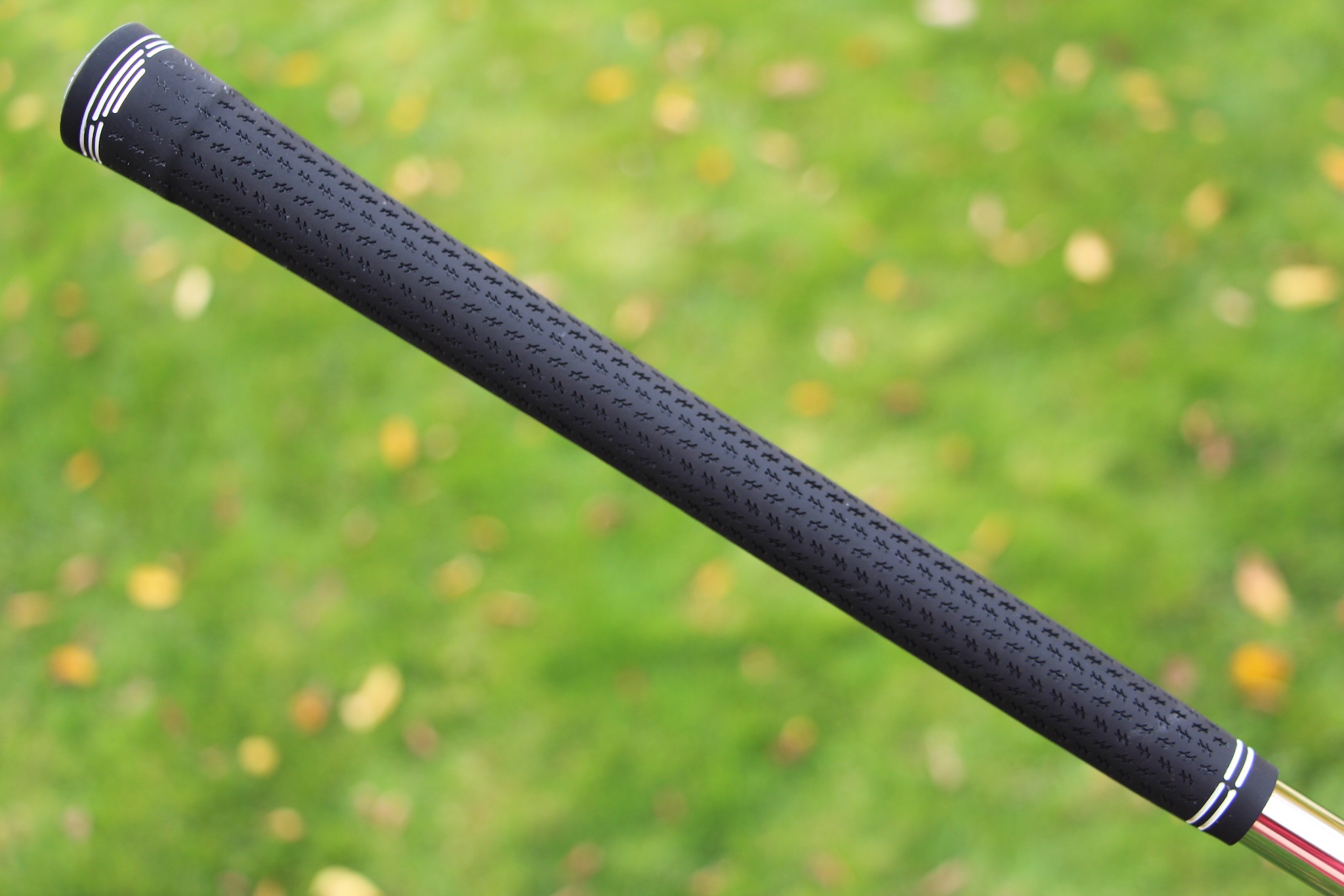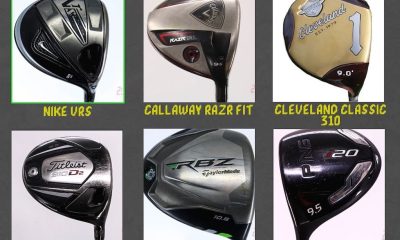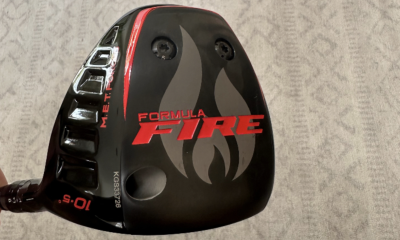Opinion & Analysis
The Wedge Guy: Size does matter (with your grips)

As most of you know, I have been in the golf equipment business for over 40 years now, and I’ve always believed and observed that one of the most overlooked pieces of our equipment is the grip, or grips, I should say. The most basic building block of a sound and repeating golf swing is the hold you make on the golf club, and I have observed that the vast majority of high-handicap players — and even many mid-handicap golfers — just do not have a sound and fundamental understanding of just how important this is to allow the golf swing to function.
I have addressed this topic before, so I’ll just advise that anyone can learn how to hold the club properly, as it takes no athletic skill at all. You can learn it at home while sitting in your chair watching TV. You can take a few minutes in your office every time you get on the phone. There are plenty of good YouTube videos on the subject, so there is just no good reason why anyone and everyone cannot learn how to hold the golf club properly.
But what I observe in almost all golfers not playing to a single-digit handicap is that they hold the club much to tightly and much too far into the palms of their hands, rather than in their fingers.
But today’s post is about the actual grips you put on your golf clubs, and how they can affect your shotmaking performance.
I have been continually amazed and surprised at the increasing percentage of Edison Forged wedges that are ordered with mid-size or even jumbo grips. By our most recent analysis, that figure is well over a third of all our orders. When I started my first company, Reid Lockhart, in the mid-1990s, these kinds of grips were not even offered, and it was a rare request to build up a grip for a customer with one or more layers of tape. Those requests typically came from very accomplished players who knew just what they wanted.
As I continued to study golfers and their equipment through my subsequent companies and witnessed a gradual increase in those requests, the grip companies began to offer their most popular grips in mid-size and jumbo size . . . and then the trend to “reduced taper” grips, wherein the right-hand portion is built up to replicate 3-4 wraps of tape under the lower hand.
But seeing how many requests we get at Edison Golf for oversized grips inspired me to reach out to an industry friend who has been in the glove business for well over 30 years to ask:
“Are golfers’ hands getting ever larger? Is that what is behind this rapid trend to bigger grips?”
His answer was a very clear: “NO – our glove size percentages have not changed measurably in over 30 years.”
So, if golfers’ hands are not getting larger, why the tremendous interest in these larger grips? The answer is very simple, as I indicated to start today’s post. If you hold the club incorrectly . . . with the “handle” more in the palms of your hands than in your fingers . . . then a properly sized grip is going to feel very small.
But why would you accommodate a poor hold on the club, instead of learning how to hold the club properly?
It has always been accepted that a larger grip reduces the activity of the hands through impact – which is why the trend to large putter grips has been so universally accepted. We want to limit our hand action in putting. I’ll even admit that the reduced taper grips can be a good idea on your wedges, because again, you would like to limit your lower hand action.
But I believe an oversized grip on your “swing clubs” is a bad idea unless you have very large hands and/or long fingers. The problem is that a big grip will feel “good” to you if you hold the club too much in your palms. But that kind of hold on the club makes it almost impossible to release the club properly through impact for optimum clubhead speed and consistency.
If any of your clubs are more than a couple of years old, chances are that the grips are worn to a point that you are having to grip the club too tightly to maintain control. As you get into this 2022 golf season, I strongly urge you to pay close attention to the condition and size of your grips and change them out if needed.
I’d also advise any of you who are playing oversized grips of some kind to try a smaller grip and move your “hold” on the club more into your fingers and out of your palms. You might just find that nice “baby draw” has been there all along.
More from the Wedge Guy
- The Wedge Guy: The secret angle of golf success
- The Wedge Guy: You can change your stripes
- The Wedge Guy: Setting goals…and achieving them
- LIKE147
- LEGIT19
- WOW3
- LOL4
- IDHT3
- FLOP6
- OB3
- SHANK42
19th Hole
Vincenzi’s 2024 Zurich Classic of New Orleans betting preview

The PGA TOUR heads to New Orleans to play the 2023 Zurich Classic of New Orleans. In a welcome change from the usual stroke play, the Zurich Classic is a team event. On Thursday and Saturday, the teams play best ball, and on Friday and Sunday the teams play alternate shot.
TPC Louisiana is a par 72 that measures 7,425 yards. The course features some short par 4s and plenty of water and bunkers, which makes for a lot of exciting risk/reward scenarios for competitors. Pete Dye designed the course in 2004 specifically for the Zurich Classic, although the event didn’t make its debut until 2007 because of Hurricane Katrina.
Coming off of the Masters and a signature event in consecutive weeks, the field this week is a step down, and understandably so. Many of the world’s top players will be using this time to rest after a busy stretch.
However, there are some interesting teams this season with some stars making surprise appearances in the team event. Some notable teams include Patrick Cantlay and Xander Schauffele, Rory McIlroy and Shane Lowry, Collin Morikawa and Kurt Kitayama, Will Zalatoris and Sahith Theegala as well as a few Canadian teams, Nick Taylor and Adam Hadwin and Taylor Pendrith and Corey Conners.
Past Winners at TPC Louisiana
- 2023: Riley/Hardy (-30)
- 2022: Cantlay/Schauffele (-29)
- 2021: Leishman/Smith (-20)
- 2019: Palmer/Rahm (-26)
- 2018: Horschel/Piercy (-22)
- 2017: Blixt/Smith (-27)
2024 Zurich Classic of New Orleans Picks
Tom Hoge/Maverick McNealy +2500 (DraftKings)
Tom Hoge is coming off of a solid T18 finish at the RBC Heritage and finished T13 at last year’s Zurich Classic alongside Harris English.
This season, Hoge is having one of his best years on Tour in terms of Strokes Gained: Approach. In his last 24 rounds, the only player to top him on the category is Scottie Scheffler. Hoge has been solid on Pete Dye designs, ranking 28th in the field over his past 36 rounds.
McNealy is also having a solid season. He’s finished T6 at the Waste Management Phoenix Open and T9 at the PLAYERS Championship. He recently started working with world renowned swing coach, Butch Harmon, and its seemingly paid dividends in 2024.
Keith Mitchell/Joel Dahmen +4000 (DraftKings)
Keith Mitchell is having a fantastic season, finishing in the top-20 of five of his past seven starts on Tour. Most recently, Mitchell finished T14 at the Valero Texas Open and gained a whopping 6.0 strokes off the tee. He finished 6th at last year’s Zurich Classic.
Joel Dahmen is having a resurgent year and has been dialed in with his irons. He also has a T11 finish at the PLAYERS Championship at TPC Sawgrass which is another Pete Dye track. With Mitchell’s length and Dahmen’s ability to put it close with his short irons, the Mitchell/Dahmen combination will be dangerous this week.
Taylor Moore/Matt NeSmith +6500 (DraftKings)
Taylor Moore has quickly developed into one of the more consistent players on Tour. He’s finished in the top-20 in three of his past four starts, including a very impressive showing at The Masters, finishing T20. He’s also finished T4 at this event in consecutive seasons alongside Matt NeSmith.
NeSmith isn’t having a great 2024, but has seemed to elevate his game in this format. He finished T26 at Pete Dye’s TPC Sawgrass, which gives the 30-year-old something to build off of. NeSmith is also a great putter on Bermudagrass, which could help elevate Moore’s ball striking prowess.
- LIKE8
- LEGIT3
- WOW1
- LOL1
- IDHT0
- FLOP3
- OB1
- SHANK2
19th Hole
Vincenzi’s 2024 LIV Adelaide betting preview: Cam Smith ready for big week down under

After having four of the top twelve players on the leaderboard at The Masters, LIV Golf is set for their fifth event of the season: LIV Adelaide.
For both LIV fans and golf fans in Australia, LIV Adelaide is one of the most anticipated events of the year. With 35,000 people expected to attend each day of the tournament, the Grange Golf Club will be crawling with fans who are passionate about the sport of golf. The 12th hole, better known as “the watering hole”, is sure to have the rowdiest of the fans cheering after a long day of drinking some Leishman Lager.
The Grange Golf Club is a par-72 that measures 6,946 yards. The course features minimal resistance, as golfers went extremely low last season. In 2023, Talor Gooch shot consecutive rounds of 62 on Thursday and Friday, giving himself a gigantic cushion heading into championship Sunday. Things got tight for a while, but in the end, the Oklahoma State product was able to hold off The Crushers’ Anirban Lahiri for a three-shot victory.
The Four Aces won the team competition with the Range Goats finishing second.
*All Images Courtesy of LIV Golf*
Past Winners at LIV Adelaide
- 2023: Talor Gooch (-19)
Stat Leaders Through LIV Miami
Green in Regulation
- Richard Bland
- Jon Rahm
- Paul Casey
Fairways Hit
- Abraham Ancer
- Graeme McDowell
- Henrik Stenson
Driving Distance
- Bryson DeChambeau
- Joaquin Niemann
- Dean Burmester
Putting
- Cameron Smith
- Louis Oosthuizen
- Matt Jones
2024 LIV Adelaide Picks
Cameron Smith +1400 (DraftKings)
When I pulled up the odds for LIV Adelaide, I was more than a little surprised to see multiple golfers listed ahead of Cameron Smith on the betting board. A few starts ago, Cam finished runner-up at LIV Hong Kong, which is a golf course that absolutely suits his eye. Augusta National in another course that Smith could roll out of bed and finish in the top-ten at, and he did so two weeks ago at The Masters, finishing T6.
At Augusta, he gained strokes on the field on approach, off the tee (slightly), and of course, around the green and putting. Smith able to get in the mix at a major championship despite coming into the week feeling under the weather tells me that his game is once again rounding into form.
The Grange Golf Club is another course that undoubtedly suits the Australian. Smith is obviously incredibly comfortable playing in front of the Aussie faithful and has won three Australian PGA Championship’s. The course is very short and will allow Smith to play conservative off the tee, mitigating his most glaring weakness. With birdies available all over the golf course, there’s a chance the event turns into a putting contest, and there’s no one on the planet I’d rather have in one of those than Cam Smith.

Louis Oosthuizen +2200 (DraftKings)
Louis Oosthuizen has simply been one of the best players on LIV in the 2024 seas0n. The South African has finished in the top-10 on the LIV leaderboard in three of his five starts, with his best coming in Jeddah, where he finished T2. Perhaps more impressively, Oosthuizen finished T7 at LIV Miami, which took place at Doral’s “Blue Monster”, an absolutely massive golf course. Given that Louis is on the shorter side in terms of distance off the tee, his ability to play well in Miami shows how dialed he is with the irons this season.
In addition to the LIV finishes, Oosthuizen won back-to-back starts on the DP World Tour in December at the Alfred Dunhill Championship and the Mauritus Open. He also finished runner-up at the end of February in the International Series Oman. The 41-year-old has been one of the most consistent performers of 2024, regardless of tour.
For the season, Louis ranks 4th on LIV in birdies made, T9 in fairways hit and first in putting. He ranks 32nd in driving distance, but that won’t be an issue at this short course. Last season, he finished T11 at the event, but was in decent position going into the final round but fell back after shooting 70 while the rest of the field went low. This season, Oosthuizen comes into the event in peak form, and the course should be a perfect fit for his smooth swing and hot putter this week.

- LIKE13
- LEGIT3
- WOW1
- LOL1
- IDHT0
- FLOP1
- OB1
- SHANK1
Opinion & Analysis
The Wedge Guy: What really makes a wedge work? Part 1

Of all the clubs in our bags, wedges are almost always the simplest in construction and, therefore, the easiest to analyze what might make one work differently from another if you know what to look for.
Wedges are a lot less mysterious than drivers, of course, as the major brands are working with a lot of “pixie dust” inside these modern marvels. That’s carrying over more to irons now, with so many new models featuring internal multi-material technologies, and almost all of them having a “badge” or insert in the back to allow more complex graphics while hiding the actual distribution of mass.
But when it comes to wedges, most on the market today are still single pieces of molded steel, either cast or forged into that shape. So, if you look closely at where the mass is distributed, it’s pretty clear how that wedge is going to perform.
To start, because of their wider soles, the majority of the mass of almost any wedge is along the bottom third of the clubhead. So, the best wedge shots are always those hit between the 2nd and 5th grooves so that more mass is directly behind that impact. Elite tour professionals practice incessantly to learn to do that consistently, wearing out a spot about the size of a penny right there. If impact moves higher than that, the face is dramatically thinner, so smash factor is compromised significantly, which reduces the overall distance the ball will fly.
Every one of us, tour players included, knows that maddening shot that we feel a bit high on the face and it doesn’t go anywhere, it’s not your fault.
If your wedges show a wear pattern the size of a silver dollar, and centered above the 3rd or 4th groove, you are not getting anywhere near the same performance from shot to shot. Robot testing proves impact even two to three grooves higher in the face can cause distance loss of up to 35 to 55 feet with modern ‘tour design’ wedges.
In addition, as impact moves above the center of mass, the golf club principle of gear effect causes the ball to fly higher with less spin. Think of modern drivers for a minute. The “holy grail” of driving is high launch and low spin, and the driver engineers are pulling out all stops to get the mass as low in the clubhead as possible to optimize this combination.
Where is all the mass in your wedges? Low. So, disregarding the higher lofts, wedges “want” to launch the ball high with low spin – exactly the opposite of what good wedge play requires penetrating ball flight with high spin.
While almost all major brand wedges have begun putting a tiny bit more thickness in the top portion of the clubhead, conventional and modern ‘tour design’ wedges perform pretty much like they always have. Elite players learn to hit those crisp, spinny penetrating wedge shots by spending lots of practice time learning to consistently make contact low in the face.
So, what about grooves and face texture?
Grooves on any club can only do so much, and no one has any material advantage here. The USGA tightly defines what we manufacturers can do with grooves and face texture, and modern manufacturing techniques allow all of us to push those limits ever closer. And we all do. End of story.
Then there’s the topic of bounce and grinds, the most complex and confusing part of the wedge formula. Many top brands offer a complex array of sole configurations, all of them admittedly specialized to a particular kind of lie or turf conditions, and/or a particular divot pattern.
But if you don’t play the same turf all the time, and make the same size divot on every swing, how would you ever figure this out?
The only way is to take any wedge you are considering and play it a few rounds, hitting all the shots you face and observing the results. There’s simply no other way.
So, hopefully this will inspire a lively conversation in our comments section, and I’ll chime in to answer any questions you might have.
And next week, I’ll dive into the rest of the wedge formula. Yes, shafts, grips and specifications are essential, too.
- LIKE36
- LEGIT7
- WOW1
- LOL1
- IDHT2
- FLOP3
- OB1
- SHANK3
-

 19th Hole3 weeks ago
19th Hole3 weeks agoDave Portnoy places monstrous outright bet for the 2024 Masters
-

 19th Hole1 week ago
19th Hole1 week agoJustin Thomas on the equipment choice of Scottie Scheffler that he thinks is ‘weird’
-

 19th Hole3 weeks ago
19th Hole3 weeks agoTiger Woods arrives at 2024 Masters equipped with a putter that may surprise you
-

 19th Hole1 week ago
19th Hole1 week ago‘Absolutely crazy’ – Major champ lays into Patrick Cantlay over his decision on final hole of RBC Heritage
-

 19th Hole2 weeks ago
19th Hole2 weeks agoTwo star names reportedly blanked Jon Rahm all week at the Masters
-

 19th Hole2 weeks ago
19th Hole2 weeks agoReport: LIV Golf identifies latest star name they hope to sign to breakaway tour
-

 19th Hole2 weeks ago
19th Hole2 weeks agoNeal Shipley presser ends in awkward fashion after reporter claims Tiger handed him note on 8th fairway
-

 19th Hole2 weeks ago
19th Hole2 weeks agoBrandel Chamblee has ‘no doubt’ who started the McIlroy/LIV rumor and why
























Greg
Feb 28, 2022 at 3:01 am
Not great analysis Terry. Perhaps the real reason for oversized grips now is people have tried them and like them. In the past, they were not commonly marketed. Now anyone can whip down to the superstore and try a bunch of different grips and choose what they like.
geohogan
Feb 27, 2022 at 1:15 pm
“It has always been accepted that a larger grip reduces the activity of the hands through impact”.
Does a large grip on a baseball bat reduce activity of the hands.. NOT.
Many if not most oversize grips are more than 50 grams…causing reduction in SW. often to mid to high “C” SW. Lower SW reduces activity of the hands through impact, not the size of the grip. Golfers have spent millions due to professional marketing.
Mike Guzman
Feb 25, 2022 at 11:23 pm
I have Arthritis in the Palms of both hand. I am able to reduce the pain in both hands by having Winn Midsize W6 Wrap Soft Grips. I am still able to maintain my “10” Handicap, while using this larger Golf Grip. I have tried using the Standard Size Winn Soft Wrap Grip, but this Grip fails the reduce the pain in my Palms and Thumbs. I have also tried using the Super Stroke Cross Comfort Golf Grips, but again these Grips fail to relieve the pain as well as the Winn W6 Midsize Grips.
Jonas
Apr 30, 2024 at 5:18 am
I can confirm this! I have quite a lot of finger pain and larger Winn grip has reduced this pain a lot!!! I have a proper “old style” golf grip and was sized for a normal size with double tape originally – moving up a size has alleviated a lot of pain without hampering my game – in fact, now that I have less pain, I can swing freely.
I have maintained a smaller grip on the wedges since I use much less force on short game.
Keith Finley
Feb 25, 2022 at 11:34 am
According to Ping, I am aqua (1/16th undersize), bit I prefer the feel of standard velvets. I get handsy with the aqua. I imagine that would go away after a while but have never pulled the trigger…
DB
Feb 25, 2022 at 8:42 am
I agree with your point, but I like +4 grips on my wedges. This allows for a similar feel when you choke down for short shots around the green. I’m curious what you think about that and if you would consider offering +4s.
ChipNRun
Feb 24, 2022 at 11:57 pm
Sounds strange, but I do best with “midsize” Midsize grips. As I discovered two years ago, not all “midsize” are created equal.
About 10 years ago, I started playing Midsize grips – usually Winn Dri-Tac. My fingers are “normal” length, but my palms are longer than average. If I spar for boxing, I need an extra four wraps in the palm to take up the slack so I don’t sprain the back of my hand. With gloves, I’m between cadet and cadet long.
My midsize discovery came when I regripped irons and wedges with Golf Pride CP2 WRAPS in Midsize. CP2 = Midsize + Low Taper, so I was leaving a lot of shots out to the right from stifled turns.
Went back to CP2 regular, and it worked OK. Redid my three MD wedges in Winn Dri-Tac Midsize, and it was just right.
Will get Dri-Tac Mid for irons and hybrids too.
Main thing midsize did was take up hand slack, and cut down amount of “fidgeting” at set-up. And, I seem to get just the right grip pressure with D-T Ms.
L
Feb 24, 2022 at 9:14 pm
Lets ask Bryson how it really is lol
Loweboy
Feb 24, 2022 at 12:14 pm
Standard grips on my irons, wedges and putter, mid-size on my driver and fairways. I cannot get used to oversized on the putter.
Mid-size on the driver and fairways to help stop my hands from flipping, but I still find a way to do it, usually when I get tired and stop swinging with my legs/hips. A full body rotation with those clubs and it’s a nice baby draw or straight piped down the middle.
JD
Feb 24, 2022 at 11:28 am
58 round Tour Velvet Cord +1 Double Side Tape. Forever & ever.